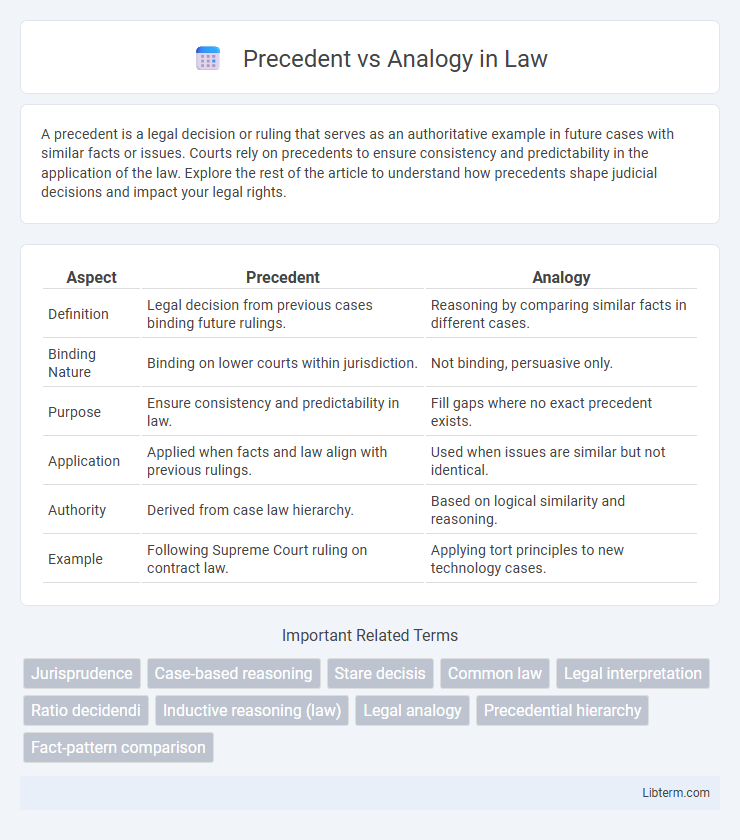A precedent is a legal decision or ruling that serves as an authoritative example in future cases with similar facts or issues. Courts rely on precedents to ensure consistency and predictability in the application of the law. Explore the rest of the article to understand how precedents shape judicial decisions and impact your legal rights.
Table of Comparison
| Aspect | Precedent | Analogy |
|---|---|---|
| Definition | Legal decision from previous cases binding future rulings. | Reasoning by comparing similar facts in different cases. |
| Binding Nature | Binding on lower courts within jurisdiction. | Not binding, persuasive only. |
| Purpose | Ensure consistency and predictability in law. | Fill gaps where no exact precedent exists. |
| Application | Applied when facts and law align with previous rulings. | Used when issues are similar but not identical. |
| Authority | Derived from case law hierarchy. | Based on logical similarity and reasoning. |
| Example | Following Supreme Court ruling on contract law. | Applying tort principles to new technology cases. |
Understanding Precedent and Analogy
Understanding precedent involves recognizing prior judicial decisions as binding authority within the same jurisdiction, ensuring consistency and predictability in legal rulings. Analogy requires comparing facts or principles from previous cases that are not directly controlling but provide persuasive reasoning for decision-making. Both tools play critical roles in legal reasoning, with precedent offering mandatory guidance and analogy aiding in interpreting novel or ambiguous legal issues.
Definition of Legal Precedent
Legal precedent refers to a judicial decision that serves as an authoritative rule or pattern in future similar cases, establishing consistency in the application of the law. It is binding on lower courts within the same jurisdiction, ensuring that legal principles are applied uniformly. Unlike analogy, which draws comparisons between different cases based on similarities, precedent relies on established court rulings to guide judicial decisions.
Definition of Analogy in Law
Analogy in law refers to the method of reasoning where legal principles from previous cases with similar facts are applied to new cases lacking direct precedent. It serves as a tool to fill gaps in the legal system when statutory law or precedent does not provide explicit guidance. This approach helps judges make consistent and fair decisions by drawing parallels between analogous situations.
Historical Origins of Precedent
The historical origins of precedent trace back to the common law system established in England during the Middle Ages, where judges relied on previously decided cases to ensure consistency and predictability in legal rulings. Precedent, or stare decisis, solidified as a doctrine allowing courts to follow earlier judgments, distinguishing it from analogy, which involves reasoning by similarity rather than binding authority. This development laid the foundation for modern legal systems to prioritize established case law over purely analogical reasoning when resolving disputes.
The Role of Analogy in Legal Reasoning
Analogy in legal reasoning serves as a crucial tool for judges to apply established principles from previous cases to novel fact patterns, enhancing the adaptability of the law. Unlike precedent, which relies on binding authority from higher courts within the jurisdiction, analogy provides persuasive guidance by highlighting relevant similarities and differences in case circumstances. This method supports the development of legal doctrines by extending existing rules to new situations where direct precedent is lacking or ambiguous.
Key Differences Between Precedent and Analogy
Precedent is a legal principle based on prior judicial decisions that bind courts in future cases with similar facts, ensuring consistency and predictability in the law. Analogy involves applying reasoning from one case to another due to similarities, but it does not have binding authority and serves as persuasive guidance. The key difference lies in precedent's obligatory nature in the same jurisdiction, whereas analogy offers flexible, non-binding support in legal reasoning.
Advantages of Relying on Precedent
Relying on precedent provides a consistent framework for judicial decisions by adhering to established legal principles, ensuring predictability in the application of laws. It allows courts to reference authoritative past rulings, reducing ambiguity and enhancing legal stability. Precedent also promotes efficiency by minimizing the need for courts to re-evaluate settled issues, streamlining case resolution processes.
Limitations of Analogy-Based Reasoning
Analogy-based reasoning often faces limitations due to its reliance on surface similarities rather than underlying legal principles, which can lead to inappropriate or misleading conclusions. Unlike precedent, which is grounded in binding judicial decisions, analogy lacks the authoritative weight and consistency required for predictable legal outcomes. This method risks oversimplification and subjective interpretation, reducing its effectiveness in complex legal disputes.
Precedent vs Analogy in Case Law
Precedent in case law refers to judicial decisions from higher courts that bind lower courts on similar issues, ensuring legal consistency and predictability. Analogy involves comparing the facts of a current case to prior cases without identical facts, using similarities to guide judicial reasoning when no direct precedent exists. While precedent provides authoritative rule application, analogy offers persuasive reasoning for case outcomes based on comparable circumstances.
Choosing Between Precedent and Analogy in Judgments
Choosing between precedent and analogy in judgments hinges on the specificity and authority of previous decisions; precedent involves applying binding rulings from higher courts within the same jurisdiction, ensuring consistency and predictability in legal outcomes. Analogy is employed when no direct precedent exists, allowing judges to draw comparisons between the current case and similar fact patterns to guide reasoning and fill legal gaps effectively. Courts prioritize precedent for maintaining judicial hierarchy but rely on analogy to adapt to novel or evolving legal issues where established rulings are insufficient.
Precedent Infographic

 libterm.com
libterm.com